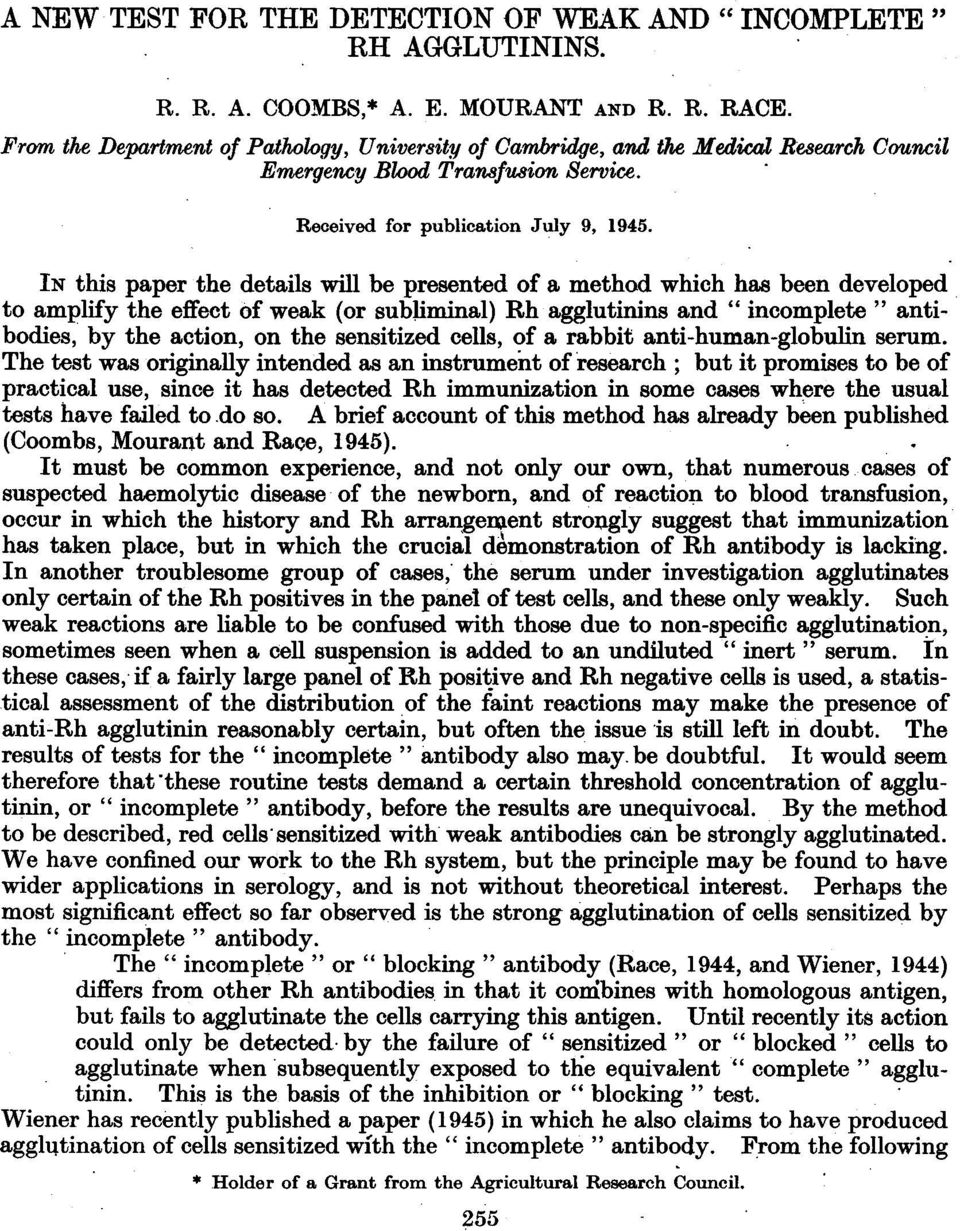Reputation Activity
-
 Arno reacted to Malcolm Needs in COMPLEMENT POS DAT AND FULL CROSSMATCH
Arno reacted to Malcolm Needs in COMPLEMENT POS DAT AND FULL CROSSMATCH
I have cited this reference over and over and over again. Sachs UJH, Röder L, Santoso S, Bein G. Does a negative direct antiglobulin test exclude warm autoimmune haemolytic anaemia? A prospective study of 504 cases. British Journal of Haematology 2006; 132: 651-661, and it refers to transfusion reactions too.
-
 Arno got a reaction from Walter Isenheim in Antibody stimulation by antigen negative blood?
Arno got a reaction from Walter Isenheim in Antibody stimulation by antigen negative blood?
Hi Rich,
I am not a clinician but as far as I know IVIG can be given to obstetrical patient in diff. conditions (autoimmune disorders, recurrent pregnancy loss, ...).
I thought about IVIG when I saw the DAT becoming positive plus additional reactions coming up over the time. Anti-A and Anti-B are indeed the most prevalent antibodies in plasma derived products but other specificities of low titre can be present sometimes such as anti-D, anti-K and a bunch of antibodies of undetermined specificity reacting with several to not say all RBCs.
Just a thought that can be doublechecked with the clinician..?
Hereunder is a very great (not recent though) paper to be read and re-read again:
Problems Associated With Passively Transfused Blood Group Alloantibodies
George Garratty, PhD, FRCPath American Journal of Clinical Pathology, Volume 109, Issue 6, 1 June 1998, Pages 769–777, https://doi.org/10.1093/ajcp/109.6.769 -
 Arno got a reaction from jojo808 in Positive Antibody screen but negative antibody ID panel
Arno got a reaction from jojo808 in Positive Antibody screen but negative antibody ID panel
Yes indeed different pH, different suppliers may explain such a behavior (some anti-M are enhanced with acidification of plasma).
In addition, Anti-M often shows dosage effect but I believe you have antigen M double dose cells on your panel too.
What are the phenotype of the 2 cells reacting in screening and the one not reacting? Is your patient antigen M negative?
It also exists the anti-M1 (the M1 antigen belongs to the MN CHO collection) that reacts with some M positive cells and stronger with M/N positive cells (M1 is expressed on M positive cells) and it can be, though rarely, produced by antigen M positive patients.
-
 Arno got a reaction from Malcolm Needs in BloodBankTalk: Clinical Aspects of Transfusion Reactions
Arno got a reaction from Malcolm Needs in BloodBankTalk: Clinical Aspects of Transfusion Reactions
I just answered this question.
My Score PASS
-
 Arno got a reaction from SbbPerson in Positive Antibody screen but negative antibody ID panel
Arno got a reaction from SbbPerson in Positive Antibody screen but negative antibody ID panel
Yes indeed different pH, different suppliers may explain such a behavior (some anti-M are enhanced with acidification of plasma).
In addition, Anti-M often shows dosage effect but I believe you have antigen M double dose cells on your panel too.
What are the phenotype of the 2 cells reacting in screening and the one not reacting? Is your patient antigen M negative?
It also exists the anti-M1 (the M1 antigen belongs to the MN CHO collection) that reacts with some M positive cells and stronger with M/N positive cells (M1 is expressed on M positive cells) and it can be, though rarely, produced by antigen M positive patients.
-
 Arno reacted to galvania in Positive antibody screen/ negative panel
Arno reacted to galvania in Positive antibody screen/ negative panel
Because I've seen so many of them………….
But actually if your panel is not in the same buffer then pH or ionic strength could be the culprit rather than the temperature.
Important to stress that these cold anti-Ms (in that they dont react strictly at 37°C) have no clinical significance.
If it happens again, you can try the following:
1. Repeat the panel, incubating for 15mins at RT (on a Coombs card). The results will be stronger in this case.
AND 2. Repeat the screen in the following way. Warm the cells to 37°C (best just to use a small aliquot - you dont want to 'cook' the whole bottle). And put the Coombs card (foil still on) in the incubator for 15mins. Put the patient's plasma in the incubator. IN the incubator, pipette 50ul of cells into the appropriate wells followed by the patient's plasma. Incubate for 15mins. At the same time, start the centrifuge empty. This warms the centrifuge up a bit. After 15mins put the incubated card into the centrifuge which will have now stopped and centrifuge immediately.
This should negativise the screen results. This is about the nearest you can get to doing a gel test at strictly 37°C
-
 Arno reacted to snance in IgA deficiency testing before convalescent plasma transfusion
Arno reacted to snance in IgA deficiency testing before convalescent plasma transfusion
The Sandler reference is Sandler, et al Transfusion 2015;55:199-204. I see the Italian document recommends testing for IgA, At a routine hospital level of detection (5mg/dL) there will be some patients interpreted as IgA deficient and deferred from getting CCP by the Italian guidelines that do have detectable IgA by more sensitive testing. There is no mention of IgA testing in the WHO Interim Guidance document (Teo D et al) posted on the ISBT Website. The USA American Rare Donor Program (ARDP) uses a level of 0.05 mg/dL to define IgA deficiency for donors and patients. The ARDP has an algorithm for requests for IgA deficient products, and in general, fills requests for IgA deficient plasma containing products only for patients having anti-IgA and/or a documented anaphylactic reaction. Red cells can, in general, be washed or be frozen/deglyced for exquisitely sensitive patients.
-
 Arno reacted to COTTONBALL in IgA deficiency testing before convalescent plasma transfusion
Arno reacted to COTTONBALL in IgA deficiency testing before convalescent plasma transfusion
Hello, thanks for your post. Anything is possible every single time we administer blood products. I agree with Neil, especially on the patient's history inquiry. I would be more concerned about other infectious bugs, than with possible rare reactions due to IgA deficiencies, and even then, I am not too concerned. At this point, an injection of CCP and prayers are in order. Patients are responding. Good day.
-
 Arno reacted to Neil Blumberg in IgA deficiency testing before convalescent plasma transfusion
Arno reacted to Neil Blumberg in IgA deficiency testing before convalescent plasma transfusion
I disagree. First of all, most patients with IgA deficiency and anti-IgA do not experience anaphylaxis. Secondly patients with anaphylaxis (a rare event indeed) do not have usually have IgA deficiency, much less anti-IgA antibody (see work by G. Sandler and colleagues refuting the ancient report of a handful of patients). Thus, to me, this is a waste of time and money and unnecessary. The key to safe plasma transfusion from this standpoint is to take about 30 minutes to run in the first 15 milliliters or so, and have a crash cart with epinephrine available should anaphylaxis occur (which, 99,999 out of 100,000 times it won't). And take a history of previous anaphylactic reactions to insect stings, dietary constituents, etc. Those patients you might want to be very careful with.
-
 Arno got a reaction from Yanxia in Positive Antibody screen but negative antibody ID panel
Arno got a reaction from Yanxia in Positive Antibody screen but negative antibody ID panel
Yes indeed different pH, different suppliers may explain such a behavior (some anti-M are enhanced with acidification of plasma).
In addition, Anti-M often shows dosage effect but I believe you have antigen M double dose cells on your panel too.
What are the phenotype of the 2 cells reacting in screening and the one not reacting? Is your patient antigen M negative?
It also exists the anti-M1 (the M1 antigen belongs to the MN CHO collection) that reacts with some M positive cells and stronger with M/N positive cells (M1 is expressed on M positive cells) and it can be, though rarely, produced by antigen M positive patients.
-
 Arno reacted to exlimey in Unidentified Antibody, Little Help Please
Arno reacted to exlimey in Unidentified Antibody, Little Help Please
It's tough to see on the scanned panel sheets, but the D- group O panel cells are w+ reactive, equivalent reactivity to the crossmatched group A cells.
-
 Arno got a reaction from John C. Staley in Positive Antibody screen but negative antibody ID panel
Arno got a reaction from John C. Staley in Positive Antibody screen but negative antibody ID panel
Yes indeed different pH, different suppliers may explain such a behavior (some anti-M are enhanced with acidification of plasma).
In addition, Anti-M often shows dosage effect but I believe you have antigen M double dose cells on your panel too.
What are the phenotype of the 2 cells reacting in screening and the one not reacting? Is your patient antigen M negative?
It also exists the anti-M1 (the M1 antigen belongs to the MN CHO collection) that reacts with some M positive cells and stronger with M/N positive cells (M1 is expressed on M positive cells) and it can be, though rarely, produced by antigen M positive patients.
-
 Arno got a reaction from Malcolm Needs in Positive Antibody screen but negative antibody ID panel
Arno got a reaction from Malcolm Needs in Positive Antibody screen but negative antibody ID panel
Yes indeed different pH, different suppliers may explain such a behavior (some anti-M are enhanced with acidification of plasma).
In addition, Anti-M often shows dosage effect but I believe you have antigen M double dose cells on your panel too.
What are the phenotype of the 2 cells reacting in screening and the one not reacting? Is your patient antigen M negative?
It also exists the anti-M1 (the M1 antigen belongs to the MN CHO collection) that reacts with some M positive cells and stronger with M/N positive cells (M1 is expressed on M positive cells) and it can be, though rarely, produced by antigen M positive patients.
-
 Arno reacted to exlimey in Positive Antibody screen but negative antibody ID panel
Arno reacted to exlimey in Positive Antibody screen but negative antibody ID panel
Reactivity with two of three cells effectively rules out the "antibody to a low incidence antigen" argument.
Is the supplier/manufacturer of the Screening Cells the same as the supplier/manufacturer of the panel ? If not, then I suspect formulation differences of the two products may be the answer, specifically pH of testing environment.
-
 Arno got a reaction from SbbPerson in Positive Antibody screen but negative antibody ID panel
Arno got a reaction from SbbPerson in Positive Antibody screen but negative antibody ID panel
In addition to what has been nicely explained by Malcolm, it could be as well an example of Sd(a++) cell (commonly named "super Sid") reacting with a weak anti-Sda. The Sda antigen is not a LFA (expressed on more than 90% of cells) though some cells "overexpresse" it.
Anti-Sda usually gives weak/DP reactions and can be neutralized using urine (contains soluble Sda substances).
Other weak antibodies may behave the same way, e.g. anti-P1 reacting against "strong P1" cells only.
However, that does not change at all what Malcolm said "I wouldn't expend too much time or energy trying to sort out the exact specificity. In all cases of such an antibody, as long as you cross-match by the same method as you used in detecting the presence of the antibody in the first place, it would be quite safe to give cross-match compatible blood."
-
 Arno reacted to Malcolm Needs in Unidentified Antibody, Little Help Please
Arno reacted to Malcolm Needs in Unidentified Antibody, Little Help Please
I think your physician's diagnosis is probably correct, as it very much looks like a "warm" auto-antibody, but you will need to ensure that there are no underlying clinically significant atypical alloantibodies.
-
 Arno reacted to galvania in Unidentified Antibody, Little Help Please
Arno reacted to galvania in Unidentified Antibody, Little Help Please
and what is wrong with this patient? what drugs is (s)he on?
-
 Arno got a reaction from Yanxia in Positive Antibody screen but negative antibody ID panel
Arno got a reaction from Yanxia in Positive Antibody screen but negative antibody ID panel
In addition to what has been nicely explained by Malcolm, it could be as well an example of Sd(a++) cell (commonly named "super Sid") reacting with a weak anti-Sda. The Sda antigen is not a LFA (expressed on more than 90% of cells) though some cells "overexpresse" it.
Anti-Sda usually gives weak/DP reactions and can be neutralized using urine (contains soluble Sda substances).
Other weak antibodies may behave the same way, e.g. anti-P1 reacting against "strong P1" cells only.
However, that does not change at all what Malcolm said "I wouldn't expend too much time or energy trying to sort out the exact specificity. In all cases of such an antibody, as long as you cross-match by the same method as you used in detecting the presence of the antibody in the first place, it would be quite safe to give cross-match compatible blood."
-
 Arno got a reaction from Malcolm Needs in Positive Antibody screen but negative antibody ID panel
Arno got a reaction from Malcolm Needs in Positive Antibody screen but negative antibody ID panel
In addition to what has been nicely explained by Malcolm, it could be as well an example of Sd(a++) cell (commonly named "super Sid") reacting with a weak anti-Sda. The Sda antigen is not a LFA (expressed on more than 90% of cells) though some cells "overexpresse" it.
Anti-Sda usually gives weak/DP reactions and can be neutralized using urine (contains soluble Sda substances).
Other weak antibodies may behave the same way, e.g. anti-P1 reacting against "strong P1" cells only.
However, that does not change at all what Malcolm said "I wouldn't expend too much time or energy trying to sort out the exact specificity. In all cases of such an antibody, as long as you cross-match by the same method as you used in detecting the presence of the antibody in the first place, it would be quite safe to give cross-match compatible blood."
-
 Arno reacted to Malcolm Needs in Positive Antibody screen but negative antibody ID panel
Arno reacted to Malcolm Needs in Positive Antibody screen but negative antibody ID panel
It sounds remarkably like one of your screening cells is expressing a low prevalence antigen that is not expressed on your panel cells.
Antibodies directed against low prevalence antigens are actually quite common, but they are rarely detected because red cells expressing the cognate antigen are so rare.
I wouldn't expend too much time or energy trying to sort out the exact specificity. In all cases of such an antibody, as long as you cross-match by the same method as you used in detecting the presence of the antibody in the first place, it would be quite safe to give cross-match compatible blood.
The other thing is that the screening cell may be expressing an HLA antigen. You could treat the cell with chloroquine, and that will get rid of the HLA antigen.
-
 Arno reacted to Neil Blumberg in Blood Bank usage by Covid19 Patients
Arno reacted to Neil Blumberg in Blood Bank usage by Covid19 Patients
Transfusing platelets (and plasma)prophylactically to patients without serious bleeding, based solely upon laboratory abnormalities of hemostasis/platelet count, is a serious clinical error in my opinion. Platelets and plasma impair host defenses against viral and bacterial infection, promote inflammation and thrombosis, and likely increase the risk of multi-organ failure. Thus I would reserve these products for situations where these serious toxicities are outweighed by the potential for treating life-threatening bleeding. This opinion is shared by one of the world's experts on hemostasis and thrombosis, the London based hematologist Beverly Hunt, who has tweeted her recommendations for these patients. See this link for her four pager on the subject.
https://twitter.com/bhwords?ref_src=twsrc^google|twcamp^serp|twgr^author
-
 Arno got a reaction from aafrin in Antibody stimulation by antigen negative blood?
Arno got a reaction from aafrin in Antibody stimulation by antigen negative blood?
Hi Rich,
I am not a clinician but as far as I know IVIG can be given to obstetrical patient in diff. conditions (autoimmune disorders, recurrent pregnancy loss, ...).
I thought about IVIG when I saw the DAT becoming positive plus additional reactions coming up over the time. Anti-A and Anti-B are indeed the most prevalent antibodies in plasma derived products but other specificities of low titre can be present sometimes such as anti-D, anti-K and a bunch of antibodies of undetermined specificity reacting with several to not say all RBCs.
Just a thought that can be doublechecked with the clinician..?
Hereunder is a very great (not recent though) paper to be read and re-read again:
Problems Associated With Passively Transfused Blood Group Alloantibodies
George Garratty, PhD, FRCPath American Journal of Clinical Pathology, Volume 109, Issue 6, 1 June 1998, Pages 769–777, https://doi.org/10.1093/ajcp/109.6.769 -
 Arno got a reaction from Ensis01 in Daratumumab patients positive with DTT treated cells
Arno got a reaction from Ensis01 in Daratumumab patients positive with DTT treated cells
In which buffer do you resuspend your DTT treated cells? May be these patients do have antibodies against one or several components of this buffer (antibodies against preservatives used in RBC buffer are not so uncommon).
-
 Arno got a reaction from e specificity in Daratumumab patients positive with DTT treated cells
Arno got a reaction from e specificity in Daratumumab patients positive with DTT treated cells
In which buffer do you resuspend your DTT treated cells? May be these patients do have antibodies against one or several components of this buffer (antibodies against preservatives used in RBC buffer are not so uncommon).
-
 Arno got a reaction from galvania in Antibody stimulation by antigen negative blood?
Arno got a reaction from galvania in Antibody stimulation by antigen negative blood?
Hi Rich,
I am not a clinician but as far as I know IVIG can be given to obstetrical patient in diff. conditions (autoimmune disorders, recurrent pregnancy loss, ...).
I thought about IVIG when I saw the DAT becoming positive plus additional reactions coming up over the time. Anti-A and Anti-B are indeed the most prevalent antibodies in plasma derived products but other specificities of low titre can be present sometimes such as anti-D, anti-K and a bunch of antibodies of undetermined specificity reacting with several to not say all RBCs.
Just a thought that can be doublechecked with the clinician..?
Hereunder is a very great (not recent though) paper to be read and re-read again:
Problems Associated With Passively Transfused Blood Group Alloantibodies
George Garratty, PhD, FRCPath American Journal of Clinical Pathology, Volume 109, Issue 6, 1 June 1998, Pages 769–777, https://doi.org/10.1093/ajcp/109.6.769







